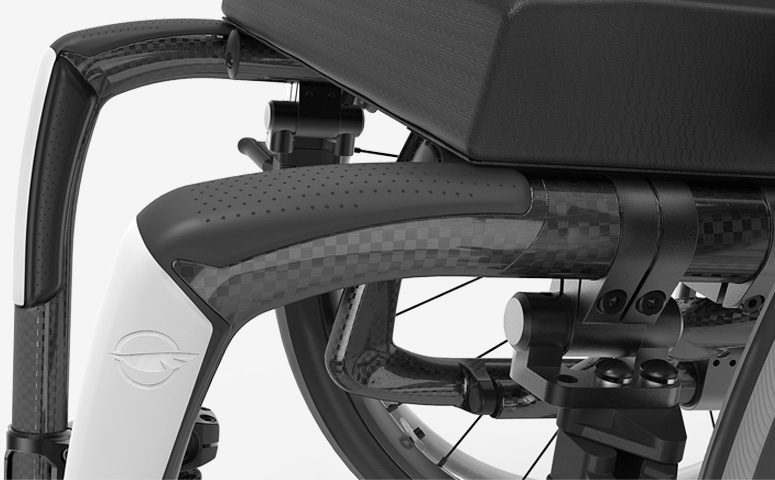
When it comes to wheelchair frames, selecting the right material is crucial for ensuring durability, strength, and overall performance. Today, we delve into the fascinating world of wheelchair frame materials, comparing the properties and benefits of four popular options: aluminium, titanium, carbon fibre, and magnesium. Each material offers distinct advantages and considerations, and understanding their unique characteristics can assist you in making an informed decision when choosing the perfect wheelchair frame for your needs. But before we delve into that, let’s address the first thing most people think about when they consider wheelchair frame material: weight.
One of the aspects of wheelchair frame materials that people like to compare is weight. We’re often asked how light a wheelchair is, and it is often automatically assumed that the lighter frame option must be better. Although weight is important, it is not the actual weight of the wheelchair that is the only factor when considering ease of propulsion and reducing the physical impact on the upper limbs. Wheelchair ‘A’ could be 8.5kg with wheels and seating fitted, and wheelchair ‘B’ could be 9.5kg with the same wheels and seating. You would assume that wheelchair ‘A’ is going to be easier to propel and feel more comfortable, but that is not necessarily the case. The set-up and configuration of the wheelchair is as much, if not more important, than the weight. We can take an ultralight 6kg wheelchair and set it up so that it feels like you’re pushing through mud, or take a 12kg wheelchair and make it feel like it takes no effort to push. You’ll still feel a difference when physically lifting the wheelchair, but not necessarily when propelling. The rear wheel position, castor position, wheel and castor choice and all those measurements and angles that make up a custom manual wheelchair prescription are so important when making a wheelchair feel light to push. When thinking about trying to get the lightest wheelchair to push, remember that weight itself is only one piece of the puzzle.
Now that we’ve somewhat addressed the weight issue, let’s go back to discussing the frame materials. Most wheelchair frame material development comes from the sporting equipment world, particularly bicycle frames. Wheelchairs are often made with a mix of materials, with a frame being one material and accessories made of another. It is common to have an aluminium or titanium framed wheelchair with a carbon fibre camber tube or carbon fibre accessories, such as side guards. As carbon fibre is a lighter material, this can help reduce the overall weight of the wheelchair (and some people enjoy the aesthetic appeal of carbon fibre accessories).
Aluminium frame
Aluminium frame wheelchairs are popular and widely used due to their versatility, durability, and cost-effectiveness. These wheelchairs offer a range of advantages that make them a practical choice for many wheelchair users. Aluminium frame wheelchairs are known for their versatility and adaptability. The material is easy to shape and mold, allowing for customisation to accommodate individual requirements. Wheelchair manufacturers can modify the frame to provide a personalised fit, ensuring optimal comfort and support. This adaptability enables users to tailor the seating system, positioning, and accessories according to their specific needs and preferences.
One of the primary benefits of aluminium frame wheelchairs is their lightweight construction. Aluminium is a lightweight material, making the overall wheelchair lighter and easier to manoeuvre. The reduced weight contributes to improved propulsion and maneuverability, reducing the effort required by the user. This feature is especially beneficial for individuals with limited upper body strength or those who require frequent transportation of their wheelchair. Despite their lightness, aluminium frame wheelchairs are still known for their durability. Aluminium is inherently strong and capable of withstanding daily use and normal wear and tear. This ensures that the wheelchair remains reliable and robust over an extended period. Additionally, aluminium's resistance to corrosion further enhances the longevity of these wheelchairs, making them suitable for various environments and weather conditions.
Another advantage of aluminium frame wheelchairs is their affordability. Aluminium is a relatively inexpensive material compared to others, such as titanium or carbon fibre. This affordability makes aluminium wheelchairs a cost-effective option for individuals seeking a reliable mobility device without breaking the bank. It allows users to access high-quality wheelchairs that meet their functional needs and budget constraints.
Wheelchair frames are typically made with an aluminium alloy, which allows the performance of the base aluminium to be improved by adding trace amounts of other metallic ‘alloying’ elements to it. This gives the various aluminium alloys varying characteristics, and these aluminium alloys are categorised into different series. Most wheelchairs are constructed of Series 6000 (aluminium with alloying elements of magnesium and silicon) or Series 7000 (aluminium with alloying element of zinc) aluminium alloys. Because Series 6000 and 7000 use different alloying elements, they have different strengths and weaknesses, and wheelchair manufacturers usually choose an aluminium series based on how they choose to use the aluminium.
We supply a range of manual wheelchairs made of aluminium from manufacturers including TiLite, RGK, Ki Mobility, Motion Composites, Progeo, Ottobock and Zippie.
Titanium frame
Titanium wheelchairs are renowned for their exceptional strength, durability, and lightweight construction. Titanium frames offer a range of advantages that make them a popular choice among wheelchair users seeking optimal performance, long-lasting reliability, and enhanced manoeuvrability.
One of the key features of titanium wheelchairs is their remarkable strength-to-weight ratio. Titanium has the highest tensile strength to density ratio of any metal and is known for being incredibly strong while maintaining a comparatively low weight. This unique combination allows for the creation of lightweight wheelchair frames that provide exceptional structural integrity and support. The reduced weight of titanium frames makes them easier to propel and manoeuvre, reducing strain on the user and enhancing overall mobility.
Durability is another significant advantage of titanium wheelchairs. Titanium is highly resistant to corrosion, ensuring that the frame remains in excellent condition even when exposed to moisture or harsh environmental conditions. This attribute makes titanium wheelchairs particularly suitable for individuals living in coastal areas or humid climates, as they can withstand the challenges of these environments and require minimal maintenance.
Titanium's resilience also contributes to the long lifespan of these wheelchairs. The material's inherent strength allows it to withstand repeated use and impact without experiencing significant wear and tear. This durability ensures that users can rely on their titanium wheelchair for extended periods, providing a reliable and robust mobility solution. Titanium's properties also enable manufacturers to mould and shape the frame according to the user's specific needs and preferences. This customisation allows for a personalised fit, ensuring optimal comfort, support, and postural alignment.
Titanium does not transmit as many vibrations through the frame compared to aluminium. For some users that feel every jolt or experience back pain when hitting bumps and lips, titanium might be a great option for them. It is also lighter than aluminium, so a wheelchair frame with the same size and characteristics but made from titanium will generally weigh less than its aluminium counterpart. Users also report that one of their favoured characteristics of titanium is that the wheelchair frame does not have to be powder coated, which means it does not develop scratches or have chipped paint. Although titanium has many benefits, it is a more expensive metal as a raw material and requires specialised manufacturing processes, and therefore the base price for a titanium frame will be more than an aluminium frame. We supply a range of manual wheelchairs made of titanium from manufacturers including TiLite, RGK, and Ki Mobility.
Carbon fibre
Carbon fibres are tiny filaments mainly consisting of carbon atoms which are combined and used on their own or woven into a fabric. The carbon fibre fabric can be mixed a plastic resin to create a strong and light composite material, and this material is what is commonly referred to as carbon fibre. Carbon fibre has a very strong strength to weight ratio, superior fatigue resistance compared to metals and is extremely resistant to corrosion.
One of the most notable features of carbon fibre wheelchairs is their incredible lightness. It is a lighter material than both aluminium and titanium, allowing for effortless propulsion and maneuvering. This characteristic is particularly advantageous for individuals who require increased mobility or have limited upper body strength. The reduced weight of carbon fiber wheelchairs minimises the strain on the user and enhances overall ease of movement.
Despite their lightweight nature, carbon fiber wheelchairs maintain exceptional strength and rigidity. The material's unique composition, consisting of tightly woven carbon fibres embedded in resin, provides outstanding structural integrity. This ensures that carbon fibre wheelchairs offer the necessary support and stability during daily activities and various terrains, without compromising on durability or longevity. Carbon fibre's inherent properties also contribute to enhanced shock absorption, making these wheelchairs well-suited for users who require a smoother ride and improved comfort. The material's natural flexibility helps to absorb vibrations and impact, reducing the transmission of bumps and uneven surfaces to the user.
Customisability is another significant advantage of carbon fibre wheelchairs. The material's versatility allows for intricate and precise molding, enabling wheelchair manufacturers to tailor the frame design to meet individual preferences and requirements. Carbon fibre frames can be shaped and adjusted to accommodate different body shapes, sizes, and postural needs. This customization ensures a personalised and comfortable fit for each user.
In addition to their functional benefits, carbon fiber wheelchairs often boast a sleek and modern appearance. The smooth finish, combined with the material's distinct pattern, gives these wheelchairs a visually appealing aesthetic. Users can enjoy the sense of style and individuality that carbon fiber frames offer, making their mobility device a reflection of their personality.
It is important to note that carbon fiber wheelchairs tend to be more expensive than traditional wheelchair models. The complex manufacturing process and the high-quality materials used contribute to their higher price point. However, many users find the performance and advantages of carbon fiber well worth the investment, as they can significantly enhance the overall mobility experience. We supply a range of manual wheelchairs made of carbon fibre from manufacturers including Motion Composites, RGK, TiLite, Progeo and Ottobock.
Magnesium
Magnesium is the newest innovative wheelchair frame material on the block, although there have been bike frames available in magnesium for a couple of decades. As it is a newer material for wheelchairs, there are only a few magnesium wheelchairs available. Known for their exceptional strength-to-weight ratio, magnesium frames offer numerous advantages that appeal to wheelchair users seeking lightweight and durable solutions. Magnesium is significantly lighter than traditional materials such as steel or aluminium, making it an excellent choice for individuals who prioritise manoeuvrability and ease of transport. The reduced weight of magnesium frames allows for effortless propulsion and maneuvering, reducing strain on the user and enhancing overall mobility.
Despite their lightweight construction, magnesium frames possess remarkable strength and rigidity. This material has excellent structural integrity, providing the necessary support and stability for users during daily activities and navigating various terrains. The combination of strength and lightness ensures that wheelchair users can confidently rely on their magnesium frames for long-term durability and reliability.
It is important to note that while magnesium frames offer various benefits, they may come at a higher cost compared to other frame materials. Magnesium frame development is slow, as the manufacturing process is energy intensive and as magnesium can be prone to corrosion it is vital to mix it with an alloy material to make it suitable for use. As wheelchair frame development continues, we may start seeing magnesium used for wheelchair frames more frequently.
As you can see, each wheelchair frame material has its pros and cons. The secret to scripting the best wheelchair is matching the frame material to the user, while ensuring the configuration of the wheelchair is optimally set up for the individual.
Our GTK Consultants are always available to provide advice on wheelchair frames and configuration. Contact us today to see how we can help.



